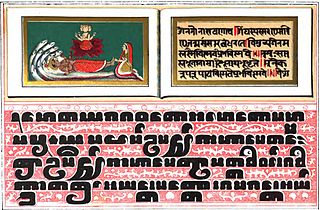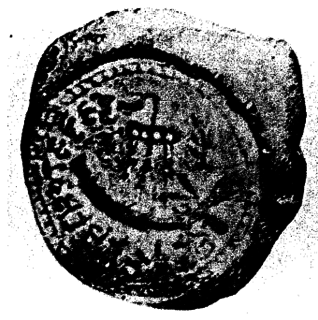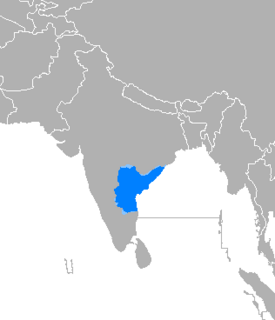
Ashoka, sometimes Ashoka the Great, was an Indian emperor of the Maurya Dynasty, who ruled almost all of the Indian subcontinent from c. 268 to 232 BCE. The grandson of the founder of the Maurya Dynasty, Chandragupta Maurya, Ashoka promoted the spread of Buddhism. Considered by many to be one of India's greatest emperors, Ashoka expanded Chandragupta's empire to reign over a realm stretching from present-day Afghanistan in the west to Bangladesh in the east. It covered the entire Indian subcontinent except for parts of present-day Tamil Nadu, Karnataka and Kerala. The empire's capital was Pataliputra, with provincial capitals at Taxila and Ujjain.

Pali or Magadhan is a Middle Indo-Aryan language native to the Indian subcontinent. It is widely studied because it is the language of the Pāli Canon or Tipiṭaka, and is the sacred language of some religious texts of Hinduism and all texts of Theravāda Buddhism. The earliest archaeological evidence of the existence of canonical Pali comes from Pyu city-states inscriptions found in Burma dated to the mid 5th to mid 6th century CE.

Sinhala, also known as Sinhalese, is the native language of the Sinhalese people, who make up the largest ethnic group in Sri Lanka, numbering about 16 million. Sinhala is also spoken as a second language by other ethnic groups in Sri Lanka, totalling about four million. It belongs to the Indo-Aryan branch of the Indo-European languages. Sinhala is written using Sinhala script, which is one of the Brahmic scripts, a descendant of the ancient Indian Brahmi script closely related to the Kadamba script.

The Odia script is a Brahmic script used to write the Odia language.
Kalinga is a historical region of India. It is generally defined as the eastern coastal region between the Mahanadi and the Godavari rivers, although its boundaries have fluctuated with the territory of its rulers. The core territory of Kalinga now encompasses a large part of Odisha and northern part of Andhra Pradesh. At its widest extent, the Kalinga region also included a part of present-day Chhattisgarh.
The Kalinga War was fought in what is now India between the Maurya Empire under Ashoka and King of Raja Anantha of the state of Kalinga, an independent feudal kingdom located on the east coast, in the present-day state of Odisha and north of Andhra Pradesh. The Kalinga War included one of the largest and bloodiest battles in Indian history. Despite an unexpectedly fierce resistance from the Kalingans, the Maurya Empire claimed victory and annexed the state of Kalinga. Kalinga did not have a king as it was culturally run without any.

Choudwar is a city and a municipality in Cuttack district in the state of Odisha, India.
The Odia (ଓଡ଼ିଆ), formerly known as Oriya, are an Indo-Aryan ethnic group native to the East Indian state of Odisha and have the Odia language as their mother tongue. They constitute a majority in the eastern coastal state of Odisha, with significant minority populations in Chhattisgarh and West Bengal.
In epigraphy, a bilingual is an inscription that includes the same text in two languages. Bilinguals are important for the decipherment of ancient writing systems, and for the study of ancient languages with small or repetitive corpora.
Sorang Sompeng script is used to write in Sora, a Munda language with 300,000 speakers in India. The script was created by Mangei Gomango in 1936 and is used in religious contexts. He was familiar with Odia, Telugu and English.
The Gajapatis were a medieval Hindu dynasty from the Indian subcontinent, which originated in the region of Odradesha from 1434 to 1541 CE. Under Kapilendra Deva, Gajapatis became an empire stretching from the lower Ganga in the north to the Kaveri in the south.

Dhauli hills are located on the banks of the river Daya, 8 km south of Bhubaneswar in Odisha (India). It is a hill with vast open space adjoining it, and has major Edicts of Ashoka engraved on a mass of rock, by the side of the road leading to the summit of the hill.
The Kadamba script marks the birth of a dedicated script for writing Kannada. It is a descendant of the Brahmi script, an abugida visually close to the Kalinga alphabet. The Kadamba script was developed during the reign of the Kadamba dynasty in the 4th–6th centuries. The Kadamba script is also known as Pre-Old-Kannada script. This script later became popular in what is today the state of Goa and was used to write Sanskrit, Kannada
Kui is a South-Central Dravidian language spoken by the Khonds. It is mostly spoken in Odisha, and written in the Odia script. With 641,662 registered native speakers, it figures at rank 29 in the 1991 Indian census. The Kui language was also referred to as the Kalinga language during the historical period.
Boitas(Odia:ବୋଇତ) were larger boats and ships that were built in ancient Kalinga kingdom during the heyday of the empire. Kalinga's sea facing regions consisting of coastal Odisha had major trading ports for which boitas were used. Ancient Oriental traders sailed from Kalinga to distant lands such of Sri Lanka and South-East Asia mostly to Java, Sumatra, Bali for trade.

Palm-leaf manuscripts are manuscripts made out of dried palm leaves. Palm leaves were used as writing materials in the Indian subcontinent and in Southeast Asia dating back to the 5th century BCE and possibly much earlier. Their use began in South Asia and spread elsewhere, as texts on dried and smoke treated palm leaves of Borassus species or the Ola leaf.

Thotlakonda Buddhist Complex is situated on a hill near Bheemunipatnam about 15 kilometres (9.3 mi) from Visakhapatnam in Andhra Pradesh, India. The hill is about 128 metres (420 ft) above sea level and overlooks the sea. The Telugu name Toṭlakoṇḍa derived from the presence of a number of rock-cut cisterns hewn into the bedrock of the hillock.

The Maritime history of Odisha, known as Kalinga in ancient times, started before 350 BC according to early sources. The people of this region of eastern India along the coast of the Bay of Bengal sailed up and down the Indian coast, and travelled to Indo China and throughout Maritime Southeast Asia, introducing elements of their culture to the people with whom they traded. The 6th century Manjusrimulakalpa mentions the Bay of Bengal as 'Kalingodra' and historically the Bay of Bengal has been called 'Kalinga Sagara', indicating the importance of Kalinga in the maritime trade. The old traditions are still celebrated in the annual Bali Jatra, or Boita-Bandana festival held for five days in October / November.











